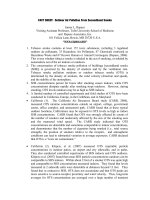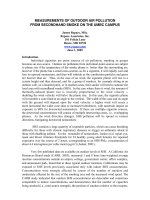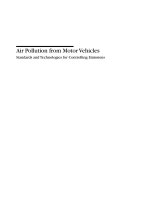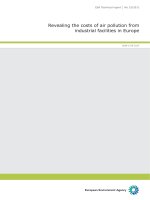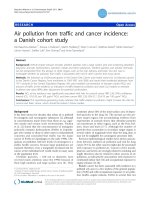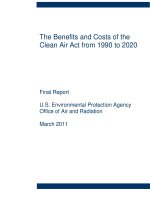Air emission from animal feedng operations
Bạn đang xem bản rút gọn của tài liệu. Xem và tải ngay bản đầy đủ của tài liệu tại đây (2.59 MB, 286 trang )
Ad Hoc Committee on Air Emissions from Animal Feeding Operations
Committee on Animal Nutrition
Board on Agriculture and Natural Resources
Board on Environmental Studies and Toxicology
Division on Earth and Life Studies
THE NATIONAL ACADEMIES PRESS
Washington, D.C.
www.nap.edu
THE NATIONAL ACADEMIES PRESS
500 Fifth Street, N.W.
Washington, DC 20001
NOTICE: The project that is the subject of this report was approved by the Governing Board of the
National Research Council, whose members are drawn from the councils of the National Academy of
Sciences, the National Academy of Engineering, and the Institute of Medicine. The members of the
committee responsible for the report were chosen for their special competences and with regard for
appropriate balance.
This study was supported by Contract No. 68-D-01-69 between the National Academy of Sciences
and the U.S. Environmental Protection Agency and Grant No. 59-0790-2-106 between the National
Academy of Sciences and the U.S. Department of Agriculture. Any opinions, findings, conclusions,
or recommendations expressed in this publication are those of the author(s) and do not necessarily
reflect the views of the organizations or agencies that provided support for the project.
International Standard Book Number: 0-309-08705-8
Library of Congress Control Number: 200310401
Additional copies of this report are available from the National Academies Press, 500 Fifth Street,
N.W., Lockbox 285, Washington, DC 20055; (800) 624-6242 or (202) 334-3313 (in the Washington
metropolitan area); Internet,
Copyright 2003 by the National Academy of Sciences. All rights reserved.
Printed in the United States of America
The National Academy of Sciences is a private, nonprofit, self-perpetuating society of
distinguished scholars engaged in scientific and engineering research, dedicated to the
furtherance of science and technology and to their use for the general welfare. Upon the
authority of the charter granted to it by the Congress in 1863, the Academy has a mandate that requires it to advise the federal government on scientific and technical matters.
Dr. Bruce M. Alberts is president of the National Academy of Sciences.
The National Academy of Engineering was established in 1964, under the charter of
the National Academy of Sciences, as a parallel organization of outstanding engineers. It
is autonomous in its administration and in the selection of its members, sharing with the
National Academy of Sciences the responsibility for advising the federal government.
The National Academy of Engineering also sponsors engineering programs aimed at
meeting national needs, encourages education and research, and recognizes the superior
achievements of engineers. Dr. Wm. A. Wulf is president of the National Academy of
Engineering.
The Institute of Medicine was established in 1970 by the National Academy of Sciences
to secure the services of eminent members of appropriate professions in the examination
of policy matters pertaining to the health of the public. The Institute acts under the
responsib-ility given to the National Academy of Sciences by its congressional charter to
be an adviser to the federal government and, upon its own initiative, to identify issues of
medical care, research, and education. Dr. Harvey V. Fineberg is president of the Institute of Medicine.
The National Research Council was organized by the National Academy of Sciences in
1916 to associate the broad community of science and technology with the Academy’s
purposes of furthering knowledge and advising the federal government. Functioning in
accordance with general policies determined by the Academy, the Council has become
the principal operating agency of both the National Academy of Sciences and the National Academy of Engineering in providing services to the government, the public, and
the scientific and engineering communities. The Council is administered jointly by both
Academies and the Institute of Medicine. Dr. Bruce M. Alberts and Dr. Wm. A. Wulf are
chair and vice chair, respectively, of the National Research Council.
www.national-academies.org
AD HOC COMMITTEE ON AIR EMISSIONS FROM ANIMAL
FEEDING OPERATIONS
PERRY R. HAGENSTEIN (Chair), Institute for Forest Analysis, Planning, and Policy,
Wayland, Massachusetts
ROBERT G. FLOCCHINI (Vice Chair), University of California, Davis, California
JOHN C. BAILAR III, University of Chicago, Chicago, Illinois
CANDIS CLAIBORN, Washington State University, Pullman, Washington
RUSSELL R. DICKERSON, University of Maryland, College Park, Maryland
JAMES N. GALLOWAY, University of Virginia, Charlottesville, Virginia
MARGARET ROSSO GROSSMAN, University of Illinois at Urbana-Champaign,
Urbana, Illinois
PRASAD KASIBHATLA, Duke University, Durham, North Carolina
RICHARD A. KOHN, University of Maryland, College Park, Maryland
MICHAEL P. LACY, University of Georgia, Athens, Georgia
CALVIN B. PARNELL, JR., Texas A&M University, College Station, Texas
ROBBI H. PRITCHARD, South Dakota State University, Brookings, South Dakota
WAYNE P. ROBARGE, North Carolina State University, Raleigh, North Carolina
DANIEL A. WUBAH, James Madison University, Harrisonburg, Virginia
KELLY D. ZERING, North Carolina State University, Raleigh, North Carolina
RUIHONG ZHANG, University of California, Davis, California
Consultant
MICHAEL OPPENHEIMER, Princeton University, Princeton, New Jersey
Staff
JAMIE JONKER, Study Director
CHAD TOLMAN, Program Officer
TANJA PILZAK, Research Assistant
JOE ESPARZA, Project Assistant
STEPHANIE PADGHAM, Project Assistant
BRYAN SHIPLEY, Project Assistant
PETER RODGERS, Intern
FLORENCE POILLON, Contract Editor
v
COMMITTEE ON ANIMAL NUTRITION
GARY L. CROMWELL (Chair), University of Kentucky, Lexington, Kentucky
C. ROSELINA ANGEL, University of Maryland, College Park, Maryland
JESSE P. GOFF, United States Department of Agriculture/Agricultural Research
Service, Ames, Iowa
RONALD W. HARDY, University of Idaho, Hagerman, Idaho
KRISTEN A. JOHNSON, Washington State University, Pullman, Washington
BRIAN W. MCBRIDE, University of Guelph, Guelph, Ontario, Canada
KEITH E. RINEHART, Perdue Farms Incorporated, Salisbury, Maryland
L. LEE SOUTHERN, Louisiana State University, Baton Rouge, Louisiana
DONALD R. TOPLIFF, West Texas A&M University, Canyon, Texas
Staff
JAMIE JONKER, Program Officer
JOE ESPARZA, Project Assistant
vi
BOARD ON AGRICULTURE AND NATURAL RESOURCES
HARLEY W. MOON (Chair), Iowa State University, Ames, Iowa
SANDRA BARTHOLMEY, Quaker Oats Company, Barrington, Illinois
DEBORAH BLUM, University of Wisconsin, Madison, Wisconsin
ROBERT B. FRIDLEY, University of California, Davis, California
BARBARA GLENN, Federation of Animal Science Societies, Bethesda, Maryland
LINDA GOLODNER, National Consumers League, Washington, D.C.
W.R. (REG) GOMES, University of California, Oakland, California
PERRY R. HAGENSTEIN, Institute for Forest Analysis, Planning, and Policy,
Wayland, Massachusetts
CALESTOUS JUMA, Harvard University, Cambridge, Massachusetts
JANET C. KING, University of California, Davis, California
WHITNEY MACMILLAN, Cargill, Incorporated, Minneapolis, Minnesota
PAMELA A. MATSON, Stanford University, Stanford, California
TERRY MEDLEY, DuPont Biosolutions Enterprise, Wilmington, Delaware
ALICE PELL, Cornell University, Ithaca, New York
SHARRON S. QUISENBERRY, Montana State University, Bozeman, Montana
NANCY J. RACHMAN, Novigen Sciences, Incorporated, Washington, D.C.
SONYA SALAMON, University of Illinois, Urbana-Champaign, Urbana, Illinois
G. EDWARD SCHUH, University of Minnesota, Minneapolis, Minnesota
BRIAN STASKAWICZ, University of California, Berkeley, California
JACK WARD THOMAS, University of Montana, Missoula, Montana
JAMES TUMLINSON, United States Department of Agriculture, Agricultural
Research Service, Gainesville, Florida
B.L. TURNER, Clark University, Worcester, Massachusetts
Staff
CHARLOTTE KIRK BAER, Director
STEPHANIE PADGHAM, Senior Project Assistant
vii
BOARD ON ENVIRONMENTAL STUDIES AND TOXICOLOGY
GORDON ORIANS (Chair), University of Washington, Seattle, Washington
JOHN DOULL (Vice Chair), University of Kansas Medical Center, Kansas City,
Missouri
DAVID ALLEN, University of Texas, Austin, Texas
THOMAS BURKE, Johns Hopkins University, Baltimore, Maryland
JUDITH C. CHOW, Desert Research Institute, Reno, Nevada
CHRISTOPHER B. FIELD, Carnegie Institute of Washington, Stanford, California
WILLIAM H. GLAZE, University of North Carolina, Chapel Hill, North Carolina
SHERRI W. GOODMAN, Center for Naval Analyses, Alexandria, Virginia
DANIEL S. GREENBAUM, Health Effects Institute, Cambridge, Massachusetts
ROGENE HENDERSON, Lovelace Respiratory Research Institute, Albuquerque,
New Mexico
CAROL HENRY, American Chemistry Council, Arlington, Virginia
ROBERT HUGGETT, Michigan State University, East Lansing, Michigan
BARRY L. JOHNSON, Emory University, Atlanta, Georgia
JAMES H. JOHNSON, Howard University, Washington, D.C.
JAMES A. MACMAHON, Utah State University, Logan, Utah
PATRICK V. O’BRIEN, Chevron Research and Technology, Richmond,
California
DOROTHY E. PATTON, International Life Sciences Institute, Washington, D.C.
ANN POWERS, Pace University School of Law, White Plains, New York
LOUISE M. RYAN, Harvard University, Boston, Massachusetts
JONATHAN M. SAMET, Johns Hopkins University, Baltimore, Maryland
KIRK SMITH, University of California, Berkeley, California
LISA SPEER, Natural Resources Defense Council, New York, New York
G. DAVID TILMAN, University of Minnesota, St. Paul, Minnesota
CHRIS G. WHIPPLE, Environ Incorporated, Emeryville, California
LAUREN A. ZEISE, California Environmental Protection Agency, Oakland,
California
Staff
JAMES J. REISA, Director
RAY WASSEL, Program Director
MIMI ANDERSON, Senior Project Assistant
Acknowledgments
This report represents the integrated efforts of many individuals. The committee thanks all those who shared their insights and knowledge to bring the
document to fruition. We also thank all those who provided information at our
public meetings and who participated in our public sessions.
During the course of its deliberations, the committee sought assistance from
several people who gave generously of their time to provide advice and information that were considered in its deliberations. Special thanks are due the following:
JOHN ALBERTSON, Duke University, Durham, North Carolina
C. RICHARD AMERMAN, United States Department of Agriculture,
Beltsville, Maryland
BOB BOTTCHER (Deceased), North Carolina State University, Raleigh,
North Carolina
GARTH BOYD, Murphy-Brown LLC, Warsaw, North Carolina
LEONARD BULL, Animal and Poultry Waste Center, Raleigh, North Carolina
TOM CHRISTENSEN, United States Department of Agriculture, Beltsville,
Maryland
JOHN D. CRENSHAW, Eastern Research Group, Research Triangle Park,
North Carolina
TONY DELANY, National Center for Atmospheric Research, Boulder,
Colorado
RALPH ERNST, University of California, Davis, California
MICHAEL FITZGIBBON, California Environmental Protection Agency,
Sacramento, California
ix
x
ACKNOWLEDGMENTS
ERIC GONDER, Goldsboro Milling Company, Goldsboro, North Carolina
ALEX GUENTHER, National Center for Atmospheric Research, Boulder,
Colorado
ELLEN HANKES, Environmental Management Solutions, LLC, Des Moines,
Iowa
LOWRY HARPER, United States Department of Agriculture, Watkinsville,
Georgia
BRUCE HARRIS, United States Environmental Protection Agency, Research
Triangle Park, North Carolina
TOM HORST, National Center for Atmospheric Research, Boulder,
Colorado
DONALD JOHNSON, Colorado State University, Fort Collins, Colorado
RENEE JOHNSON, United States Environmental Protection Agency,
Washington, D.C.
RAY KNIGHTON, United States Department of Agriculture, Beltsville,
Maryland
GARY MARGHEIM, United States Department of Agriculture, Washington,
D.C.
JOHN H. MARTIN, JR., Hall Associates, Dover, Delaware
F. ROBERT MCGREGOR, Water and Waste Engineering, Incorporated,
Denver, Colorado
DEANNE MEYER, University of California, Davis, California
BOB MOSER, ConAgra Beef, Kersey, Colorado
DANIEL MURPHY, National Oceanic and Atmospheric Administration,
Boulder, Colorado
BRENT NEWELL, California Rural Legal Assistance Foundation,
Sacramento, California
ROY OOMMEN, Eastern Research Group, Research Triangle Park, North
Carolina
JOSEPH RUDEK, Environmental Defense, Raleigh, North Carolina
GARY SAUNDERS, North Carolina Department of Environment and Natural
Resources, Raleigh, North Carolina
SUSAN SCHIFFMAN, Duke University, Durham, North Carolina
SALLY SHAVER, United States Environmental Protection Agency, Research
Triangle Park, North Carolina
MARK SOBSEY, University of North Carolina, Chapel Hill, North Carolina
JOHN SWEETEN, Texas A&M University, Amarillo, Texas
DAVID TOWNSEND, Premium Standard Farms Research and Development,
Kansas City, Missouri
RANDY WAITE, United States Environmental Protection Agency, Research
Triangle Park, North Carolina
JOHN T. WALKER, United States Environmental Protection Agency,
Research Triangle Park, North Carolina
ACKNOWLEDGMENTS
xi
The committee is grateful to members of the National Research Council staff
who worked diligently to maintain progress and quality in its work.
The report has been reviewed in draft form by individuals chosen for their
diverse perspectives and technical expertise, in accordance with procedures approved by the National Research Council’s Report Review Committee. The purpose of this independent review is to provide candid and critical comments that
will assist the institution in making its published report as sound as possible and
to ensure that the report meets institutional standards for objectivity, evidence,
and responsiveness to the study charge. The review comments and draft manuscript remain confidential to protect the integrity of the deliberative process. We
wish to thank the following individuals for their review of this report:
DAVID T. ALLEN, The University of Texas, Austin, Texas
WILLIAM BATTYE, EC/R Incorporated, Chapel Hill, North Carolina
VAN C. BOWERSOX, Illinois State Water Survey, Champaign, Illinois
ELLIS B. COWLING, North Carolina State University, Raleigh, North
Carolina
DANNY G. FOX, Cornell University, Ithaca, New York
ROGENE HENDERSON, National Environmental Respiratory Center,
Albuquerque, New Mexico
KRISTEN A. JOHNSON, Washington State University, Pullman, Washington
DEANNE MEYER, University of California, Davis, California
GEORGE MOUNT, Washington State University, Pullman, Washington
ROGER A. PIELKE, Colorado State University, Fort Collins, Colorado
WENDY J. POWERS, Iowa State University, Ames, Iowa
JOSEPH RUDEK, Environmental Defense, Raleigh, North Carolina
MARGOT RUDSTROM, University of Minnesota, Morris, Minnesota
Although the reviewers listed above have provided many constructive comments and suggestions, they were not asked to endorse the conclusions or recommendations, nor did they see the final draft of the report before its release. The
review of this report was overseen by Bob Frosch, Harvard University, Cambridge, Massachusetts, and Albert Heber, Purdue University, West Lafayette, Indiana. Appointed by the National Research Council, they were responsible for
making certain that an independent examination of this report was carried out in
accordance with institutional procedures and that all review comments were carefully considered. Responsibility for the final content of this report rests entirely
with the authoring committee and the institution.
Preface
The increasing concentration of food production—meat, eggs, milk—from
animals in very large feeding operations has focused public attention on associated environmental issues. These include the effects of air emissions, especially
those that come from the large quantities of manure produced by the animals.
While concern has mounted, research to provide the basic information needed for
effective regulation and management of these emissions has languished.
This report, prepared by a committee appointed by the National Research
Council, proposes two major ways to improve information and the nation’s ability to deal with the effects of these emissions. One is to change the way in which
the rates and fate of air emissions are estimated and tracked. The proposal would
replace the current “emission factor” approach with a “process-based modeling”
approach. This can, if pursued vigorously, enhance both regulation and management of air emissions in the next two to five years.
The other proposal is for a research program that views air emissions as one
part of the overall system of producing food from animal feeding operations with
the goal of eliminating the release of unwanted emissions into the environment.
This “systems-based” proposal, if also pursued vigorously, would lead to fundamentally changed practices at animal feeding operations. The net result would be
continued food production with greatly reduced adverse environmental effects.
The 16-person committee that produced this report and an earlier interim
report worked hard and well. The time allowed for producing the two reports was
short, but committee members found time in their schedules to address what each
sees as an important issue that needs attention. The project staff at the Board on
Agriculture and Natural Resources, Jamie Jonker, study director, and Tanja
Pilzak, research assistant, and the Board on Environmental Studies and Toxicolxiii
xiv
PREFACE
ogy, Chad Tolman, program officer, deserve special thanks for their long hours of
very effective work. An informal editorial subcommittee that handled reviewer
comments and provided enormous help throughout also deserves special thanks.
The members were Chair Perry Hagenstein, Vice Chair Bob Flocchini, Jim Galloway, Rick Kohn, and, for the interim report, Wayne Robarge.
Perry Hagenstein, Chair
Robert Flocchini, Vice Chair
Committee on Air Emissions from
Animal Feeding Operations
Contents
EXECUTIVE SUMMARY
1
1
INTRODUCTION
Basis for this Report, 14
Concerns with Air Emissions, 15
The Interim Report, 15
Scale and Impact of Emissions from Animal Feeding
Operations, 17
Policy Context, 22
Science Context, 23
Challenges, 24
Structure of the Final Report, 24
2
LIVESTOCK AGRICULTURE AND ANIMAL FEEDING
OPERATIONS
Introduction, 26
Livestock Agriculture, 26
Economics of Livestock Agriculture, 27
Summary, 49
3
AIR EMISSIONS
Introduction, 50
Species of Interest, 50
Factors Affecting Air Emissions, 57
Dispersion of Air Emissions—Meteorological considerations, 63
xv
14
26
50
xvi
CONTENTS
Potential Impacts, 65
Summary, 73
4
MEASURING EMISSIONS
Introduction, 74
Calibration, Sampling, and Concentration Measurements, 76
Measuring Concentrations and Compositions, 78
Measuring Emissions, 87
Air Quality Monitoring, 96
Summary, 96
74
5
APPROACHES FOR ESTIMATING EMISSIONS
Introduction, 98
Emission Factor Estimates, 99
Multiple Regression Approach to Develop Emission Factors, 102
Process-Based Modeling Approach, 103
Summary, 128
98
6
GOVERNMENT REGULATIONS AND PROGRAMS
Introduction, 129
Clean Air Act, 131
CERCLA and EPCRA, 138
Clean Water Act, 140
Coastal Zone Management Act, 145
The Role of USDA, 146
Summary, 151
129
7
IMPROVING KNOWLEDGE AND PRACTICES
Introduction, 152
Short-Term Research, 154
Long-Term Research, 161
Summary, 168
152
8
CONCLUSIONS
Setting Priorities, 170
Estimating Air Emissions, 171
Systems Approach, 172
Research Needs, 173
169
REFERENCES
176
CONTENTS
xvii
APPENDIXES
A Statement of Task
B Acronyms and Glossary
C Bioaerosols
D Nitrogen and Sulfur Contents of Animal Products and
Live Animals—Sample Excretion Predictions
E Animal Units
F Ammonia Emissions from Manure Storage
G Regulatory Action Levels by Selected Atmospheric Pollutant
H Regulatory Action Levels by Regulatory Requirement and
Action Status
I Emission Factors for a Feed Mill or Grain Elevator
J Public Meeting Agendas
K Geographic Distribution of Livestock and Poultry Production
in the United States for 1997
L Emission Factors in Published Literature
195
197
198
205
207
214
217
222
224
226
228
234
241
ABOUT THE AUTHORS
255
BOARD ON AGRICULTURE AND NATURAL RESOURCES
PUBLICATIONS
261
Tables, Figures, and Boxes
TABLES
ES-1
Committee’s Scientific Evaluation of the Potential Importance of
AFO Emissions at Different Spatial Scales, 5
1-1
Substances in AFO Emissions That the Committee Was Tasked to
Address and Their Respective Classifications, 16
2-1
U.S. Per Capita Consumption of Meat, Dairy Products, and Eggs in
2001, 28
Leading Livestock Production States by Animal Sector, 33
Number of Animals per EPA Animal Unit, 34
2-2
2-3
3-1
3-2
3-3
3-4
3-5
3-6
3-7
Annual Anthropogenic Emissions of Constituents of Concern,
1990, 51
Measured Emission Fluxes of Ammonia from Primary Anaerobic
Swine Lagoons as a Function of Measurement Method and
Period, 58
Relationship of Management Practices on 4 percent Fat Corrected
Milk and Nitrogen Utilization Efficiency, 62
Typical Lifetimes in the Planetary Boundary Layer for Pollutants
Emitted from Animal Feeding Operations, 64
Short-Term Exposure to Ammonia, 66
Long-Term Exposure to Ammonia, 67
Committee’s Scientific Evaluation of the Potential Importance of
AFO Emissions at Different Spatial Scales, 72
xix
xx
TABLES, FIGURES, AND BOXES
5-1
Maximum Methane Production Potential of Animal Manure as
Affected by Different Diets, 120
6-1
Overview of Federal Statutes and Their Provisions, 131
8-1
Committee’s Scientific Evaluation of the Potential Importance of
AFO Emissions at Different Spatial Scales, 170
D-1
D-2
D-3
Typical Nitrogen and Sulfur Content of Animal Products, 208
Nitrogen and Sulfur Content of Animal Live Weight Gain, 210
Sample Excretion Predictions Directly from Different Types of
Food Production Animals, 211
L-1
Odor Emission Rates from Animal Housing as Reported in the
Literature, 254
FIGURES
1-1
Mass flows (teragrams of nitrogen per year) of new reactive nitrogen in U.S. agriculture in 1997, 21
3-1
Relative excretion rate of nitrogen versus day in the life cycle of a
grow-finish hog at a commercial swine production facility in the
southeastern United States, 60
Nitrogen cascade, 70
3-2
4-1
4-2
4-3
4-4
4-5
Ammonia concentrations (averaged over a 68-m path) measured
near a dairy wastewater lagoon, 76
Schematic illustrating the essential elements associated with measurement of emissions from agricultural sources that can be characterized as low-level point sources such as cotton gins, feed mills,
grain elevators, and oil mills, 87
Schematic illustrating the essential elements associated with measurement of emissions from agricultural sources that can be characterized as ground-level area sources such as dairies, cattle feed
yards, field operation, and agricultural burning, 88
Schematic illustrating the essential element associated with regulation of emissions from agricultural sources that can be characterized
as low-level point sources such as tunnel-ventilated AFOs, 89
Schematic illustrating the essential element associated with regulation of emissions from agricultural sources that can be characterized
as low-level point sources such as naturally ventilated AFOs, 91
xxi
TABLES, FIGURES, AND BOXES
5-1
A schematic representation of a process-based model of emissions
from an animal production system, 104
7-1
Animal feeding operations system (animal plus associated cropland), 162
D-1
Change in body protein percentage as cattle mature, 209
K-1
K-2
Distribution of milk cows in 1997, 235
Distribution of cattle fattened on grain and concentrates and sold in
1997, 236
Distribution of hogs and pigs sold in 1997, 237
Distribution of broilers and other meat-type chickens sold in
1997, 238
Distribution of turkeys sold in 1997, 239
Distribution of layers and pullets, 13 weeks old and older in
1997, 240
K-3
K-4
K-5
K-6
BOXES
ES-1
Findings from the Interim Report, 3
1-1
2-1
Findings and Discussion from the Interim Report, 18
Poultry Production in the United States, 33
5-1
Sample Calculations of Whole-Farm Nitrogen Balance, 116
Executive Summary
Public concerns about the environmental effects and, to a lesser extent, the
possible health effects of air emissions from animal feeding operations (AFOs,
see Appendix B) have grown with the increasing size and geographic concentration of these operations. This intensification has been driven by the economics of
domestic and export markets for meat, poultry, milk, and eggs. Public concerns
have also grown as the population, both exurbanites and expanding urban centers,
have moved into what had been largely rural farming areas. Objectionable odors
from AFOs are a significant concern not only to the new residents in these areas,
but also to many long-time residents.
Prompted by legislation, especially the Clean Air Act (CAA), as well as by
public concerns, the U.S. Environmental Protection Agency (EPA) has been considering what information is needed to define and support feasible regulation of
air emissions from AFOs. At the same time, the U.S. Department of Agriculture
(USDA) has been using its authority to aid farmers in mitigating the effects of air
emissions with modified agricultural practices. Acting jointly, these two agencies
asked the Board on Agriculture and Natural Resources (BANR) to evaluate the
scientific information needed to address these issues. A 16-person ad hoc committee was appointed, the Committee on Air Emissions from Animal Feeding
Operations, which has been guided by a Statement of Task that was agreed upon
by the National Academies and the sponsoring agencies (Appendix A).
The Statement of Task directed the committee to
• review and evaluate the scientific basis for estimating the emissions to the
atmosphere of various specified substances from confined livestock and
poultry operations;
1
2
AIR EMISSIONS FROM ANIMAL FEEDING OPERATIONS
• review the characteristics of the agricultural animal industries, methods
for measuring and estimating air emissions, and potential best management practices for mitigating emissions;
• evaluate confined animal feeding production systems in terms of biologic
systems; and
• identify critical short- and long-term research needs and recommend
methodologic and modeling approaches for estimating and measuring air
emissions and potential mitigation technologies.
Making scientifically credible estimates of air emissions from AFOs is complicated by various factors that affect the amounts and dispersion of emissions in
the atmosphere. Such factors include the kinds and numbers of animals involved,
their diets and housing, the management of their manure (feces and urine, which
may also include litter or bedding materials), topography, climatic and weather
conditions, and actions taken to mitigate the emissions and their effects. Estimates of emissions generated for one set of conditions or for one type of AFO
may not translate readily to others.
Accurate estimation of air emissions from AFOs is needed to gauge their
possible adverse impacts and the subsequent implementation of control measures.
For example, increasing pressure is being placed on EPA to address these emissions through the Clean Air Act and other federal laws and regulations. EPA is
under court order to establish new water quality rules for AFOs by December
2002. The need to understand the relationship between actions to mitigate the
effects of manure management on water quality and its related effects on air
quality prompted EPA to ask for an interim report several months in advance of
this final report. The committee’s findings in the interim report (Box ES-1) are
encompassed and extended by the findings and recommendations in this report.
The contents, including the findings and recommendations, of this report
represent the consensus views of the committee and have been formally reviewed
in accordance with National Research Council procedures. In addressing its Statement of Task, the committee has come to consensus on 13 major findings, each
accompanied by one or more related recommendations. The basis of these findings is discussed more extensively in the body of the report.
FINDINGS AND RECOMMENDATIONS
Animal Units
EPA defines animal units differently than USDA. An EPA animal unit is
equal to 1.0 slaughter and feeder cattle, 0.7 mature dairy cows, 2.5 pigs weighing
more than 55 pounds, 10 sheep or lambs, and 0.5 horses. USDA defines animal
unit as 454 kg (1000 pounds) of animal live weight regardless of species. A consistent basis for defining animal unit will decrease confusion that may exist be-

